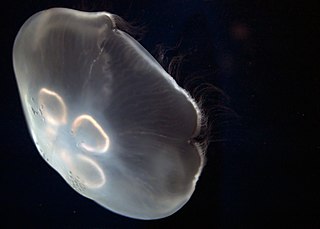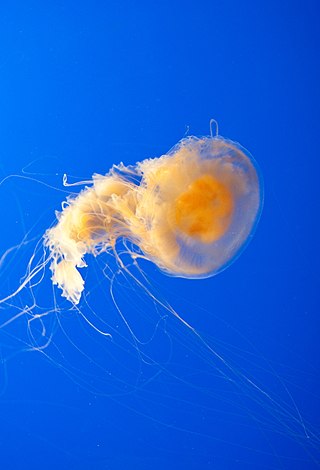
Cnidaria is a phylum under kingdom Animalia containing over 11,000 species of aquatic animals found both in fresh water and marine environments, including jellyfish, hydroids, sea anemones, corals and some of the smallest marine parasites. Their distinguishing features are a decentralized nervous system distributed throughout a gelatinous body and the presence of cnidocytes or cnidoblasts, specialized cells with ejectable flagella used mainly for envenomation and capturing prey. Their bodies consist of mesoglea, a non-living, jelly-like substance, sandwiched between two layers of epithelium that are mostly one cell thick. Cnidarians are also some of the only animals that can reproduce both sexually and asexually.

Jellyfish, also known as sea jellies, are the medusa-phase of certain gelatinous members of the subphylum Medusozoa, which is a major part of the phylum Cnidaria.

The Scyphozoa are an exclusively marine class of the phylum Cnidaria, referred to as the true jellyfish.

Aurelia aurita is a species of the family Ulmaridae. All species in the genus are very similar, and it is difficult to identify Aurelia medusae without genetic sampling; most of what follows applies equally to all species of the genus.

Rhopalia from Ancient Greek ῥόπαλον (rhópalon) 'club' are small sensory structures of certain Scyphozoan and Cubozoan species.

Medusozoa is a clade in the phylum Cnidaria, and is often considered a subphylum. It includes the classes Hydrozoa, Scyphozoa, Staurozoa and Cubozoa, and possibly the parasitic Polypodiozoa. Medusozoans are distinguished by having a medusa stage in their often complex life cycle, a medusa typically being an umbrella-shaped body with stinging tentacles around the edge. With the exception of some Hydrozoa, all are called jellyfish in their free-swimming medusa phase.

Phacellophora camtschatica, commonly known as the fried egg jellyfish or egg-yolk jellyfish, is a very large jellyfish in the family Phacellophoridae. This species can be easily identified by the yellow coloration in the center of its body which closely resembles an egg yolk, hence its common name. Some individuals can have a bell close to 60 cm (2 ft) in diameter, and most individuals have 16 clusters of up to a few dozen tentacles, each up to 6 m (20 ft) long. A smaller jellyfish, Cotylorhiza tuberculata, typically found in warmer water, particularly in the Mediterranean Sea, is also popularly called a fried egg jellyfish. Also, P. camtschatica is sometimes confused with the Lion's mane jellyfish.

Chrysaora hysoscella, the compass jellyfish, is a common species of jellyfish that inhabits coastal waters in temperate regions of the northeastern Atlantic Ocean, including the North Sea and Mediterranean Sea. In the past it was also recorded in the southeastern Atlantic, including South Africa, but this was caused by confusion with close relatives; C. africana, C. fulgida and an undescribed species tentatively referred to as "C. agulhensis".

Aurelia is a genus of jellyfish that are commonly called moon jellies, which are in the class Scyphozoa. There are currently 25 accepted species and many that are still not formally described.

Catostylus mosaicus is also known as the Jelly blubber or Blue blubber jellyfish. The jelly blubber is distinguishable by its color, which ranges from light blue to a dark blue or purple, and its large (250-300mm), rounded bell which pulses in a staccato rhythm. It occurs along the coastline of Eastern Australia in estuaries and shallow bays, and often blooms to high abundance.

Cyanea is a genus of jellyfish, primarily found in northern waters of the Atlantic and Pacific Oceans and southern Pacific waters of Australia and New Zealand, there are also several boreal, polar, tropical and sub-tropical species. Commonly found in and associated with rivers and fjords. The same genus name has been given to a genus of plants of the Hawaiian lobelioids, an example of a parahomonym.

Drymonema larsoni is a species of jellyfish belonging to the class Scyphozoa. Following a mass sighting in 2000 in the Gulf of Mexico, the species and the rest of its genus were put in their own family, a new subset of the true jellyfish. They were originally thought to be a member of the same family as the lion's mane jellyfish, Cyanea capillata Linnaeus, but they were shown to have morphological and molecular differences. Drymonema larsoni prey heavily upon jellyfish species belonging to the genus Aurelia, and they play an important role in controlling the population of these species.

Rhopilema verrilli, or mushroom cap jellyfish, is a species of jellyfish in the family Rhizostomatidae. They are cnidarian invertebrates distinguished by their mushroom-shaped medusae. The species does not have any tentacles; however, they still have stinging cells, called nematocysts, within their bells, which can produce mild stings to humans.

Sanderia malayensis is a species of jellyfish in the family Pelagiidae, native to the tropical Indo-Pacific. It has a complex life cycle and is thought to be venomous and to have caused injuries to humans.

The South American sea nettle is a species of jellyfish from the family Pelagiidae. It is found from the Pacific coast of Peru, south along Chile's coast to Tierra del Fuego, and north along the Atlantic coast of Argentina, with a few records from Uruguay. Despite its common name, it is not the only sea nettle in South America. For example, C. lactea is another type of sea nettle in this region. Historically, C. plocamia was often confused with C. hysoscella, a species now known to be restricted to the northeast Atlantic. C. plocamia is a large jellyfish, up to 1 m in bell diameter, although most mature individuals only are 25–40 cm (10–16 in).
Chiropsella bronzie is a species of box jellyfish. It is considered much less of a threat to humans than some of its relatives. The species was described in 2006, and is one of four species in the genus Chiropsella. Chiropsella bronzie can be found in shallow waters off the coast of Queensland, Australia.

Desmonema is a genus of jellyfish under the Cyaneidae family found in colder waters near the Antarctic region and off of the coast of Argentina. They have a bell diameter that can extend over 1 meter and wide tentacles that are grouped together in clusters. They share similar anatomical and physiological structures to the genus Cyanea. Their sophisticated structures like the thick tentacles, sensory systems, and gastrovascular system allow Desmonema to easily capture and extracellularly digest their prey. In recent years, Desmonema were reported to have a commensal relationship with fishes under the Trachurus genus and a parasitic relationship with specimens of the Hyperia genus. The genus name derives from the Ancient Greek desmós (δεσμός), meaning "bond", and nêma (νῆμᾰ), meaning "thread".

Aurelia coerulea or Asian moon jelly is a species of moon jelly in the genus Aurelia. This species is native to the seas off Japan, China, Korea, and California, as well as the Mediterranean and other temperate seas. and they can also be found in coastal areas of China, Korea, California, the Mediterranean and other temperate seas. It is particularly abundant in artificial habitats and sheltered regions. It has a very high reproductive rate which can cause blooming events. A.coerulea blooming causes problems such as impairing fisheries, clogging the nuclear power plants and disrupting the local zooplankton abundance. The chemical compounds the species secretes as a self-defense mechanism can be used for pharmaceutical purposes.

Cyanea fulva, the Atlantic lion's mane jellyfish, is a species of jellyfish found along the Mid-Atlantic coastal region of the United States. C. fulva are commonly noted as being about two inches in diameter and smaller than C. capillata, however, larger than C. versicolor, a co-occurring close species. One distinctive feature present in mature C. fulva populations is their four mouth-part tentacles, containing a cinnamon color with the center of the main cavity being darker. At a young age, these jellyfish can have three appendages but often gain a fourth at more developed life cycle stages. C. fulva are also known for having less folds compared to C. arctica but more folds compared to C. versicolor. These folds are described as being remarkably thin and deciduous.

Aurelia marginalis is a species of the genus Aurelia. All species in the genus are very similar, and it is difficult to identify Aurelia medusae without genetic sampling.


















